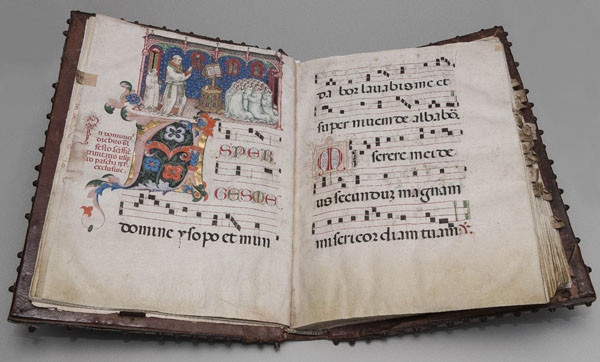The Olivetan Gradual (Beinecke MS 1184) is a stunning 15th-century example of the gradual, a liturgical book containing the musical components of the Mass in written notation. Susan Weil, whose husband Kenneth M. Weil graduated from Yale in 1945, generously donated this lavishly illuminated manuscript to the Beinecke Library earlier this year. Mrs. Weil’s gift reflects her husband’s affection for Yale and her appreciation of the artistry found in medieval manuscripts.
Graduals were immensely practical items, intended to be sight-read, usually by multiple people in an ensemble performance. The Olivetan Gradual is a book of great significance both aesthetically and functionally. Massive, leather-bound, and covered in metalwork, the gradual’s pages feature the geometric regularity and simplicity of medieval musical notation. The accompanying text boasts beautifully decorated red and blue pen work initials, some 11 of which are on gold grounds. Five miniatures, or illustrations, depicting religious subject matter are likewise distributed throughout the manuscript.
Remarkably, the name of the artist who probably produced at least the miniatures is known: Girolamo da Milano, conventionally called “the Olivetan Master,” who was, prior to the discovery of the Beinecke’s manuscript, known primarily for cuttings of his miniatures pasted into other manuscripts. This places the gradual firmly in the context of northern Italian (Lombard) manuscript production and sheds some light on the Olivetan Order, a lesser-known offshoot of the Benedictines, for whose house of Santa Maria di Baggio the manuscript was almost assuredly produced. Tabs, marks, and other additions betray a long history of ecclesiastical use.
Sebastian Rider-Bezerra
Ph.D. student in Medieval Studies
